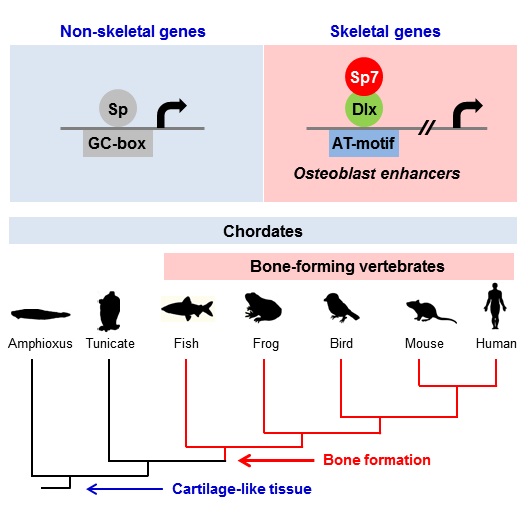Novel gene regulatory mechanism in bone formation and its evolutionary significance Mode of action of essential transcriptional regulator in bones


Mode of Sp7/osterix action during osteoblast differentiation and significance in vertebrate evolution
Studies to date have proposed that Sp7/osterix regulates gene transcription by directly binding to a specific sequence (GC box) on the genome. However, this study suggests that Sp7/osterix engages gene targets indirectly by forming a complex with homeobox transcription factors. Cross-species analysis further proposes that the emergence of Sp7/osterix is closely coupled to the evolution of bone-forming vertebrates.
© 2016 Hironori Hojo.
A collaborative research group from the University of Tokyo and University of Southern California has identified a mode of action of Sp7/osterix, a transcriptional regulator necessary for bone formation, by examining how Sp7/osterix-mediated gene transcription is regulated over the whole genome in osteoblasts. This finding will contribute to the understanding of diseases of the skeleton and genome-based drug discovery for treatments and skeletal regeneration.
Bone is formed of cells called osteoblasts. Bone formation requires the normal function of the protein Sp7/osterix, a member of a group of proteins called the Sp transcription family that acts as a switch to regulate the expression of osteoblast-related genes. Although the mechanisms underlying Sp7/osterix-mediated transcriptional regulation have been uncovered at a certain part of the genome, its genome-wide regulation remained unclear.
In this study, the research group of Project Associate Professor Shinsuke Ohba (University of Tokyo Graduate School of Engineering), Postdoctoral Research Associate Hironori Hojo and Professor Andrew P. McMahon (University of Southern California) identified a new mode of Sp7/osterix action. It was thought that Sp7/osterix regulated gene transcription by binding directly to a specific part of the genome called GC box. However, the group discovered that Sp7/osterix regulates the transcription of osteoblast-related genes by indirectly binding to the genome via another protein called the homeobox transcription factor Dlx. In addition, evolutionary analyses across different species suggest that the emergence of Sp7/osterix, whose modes of action are distinct from those of other Sp family members, are closely coupled to the emergence of bone-forming osteoblasts in the evolution of vertebrates.
“This finding is a milestone in our research goal of drawing a blue print of bone formation based on genomic information and utilizing it to cure bone diseases,” say Ohba and Hojo.
This work was published in the online version of Developmental Cell (Cell Press) on May 9th, 2016.
Paper
, "Sp7/Osterix is restricted to bone-forming vertebrates where it acts as a Dlx co-factor in osteoblast specification", Developmental Cell Online Edition: 2016/05/10 (Japan time), doi: 10.1016/j.devcel.2016.04.002.
Article link (Publication)
Links
Graduate School of Engineering
Department of Bioengineering, Graduate School of Engineering
Ohba-Tei/Chung lab, Department of Bioengineering, Graduate School of Engineering






